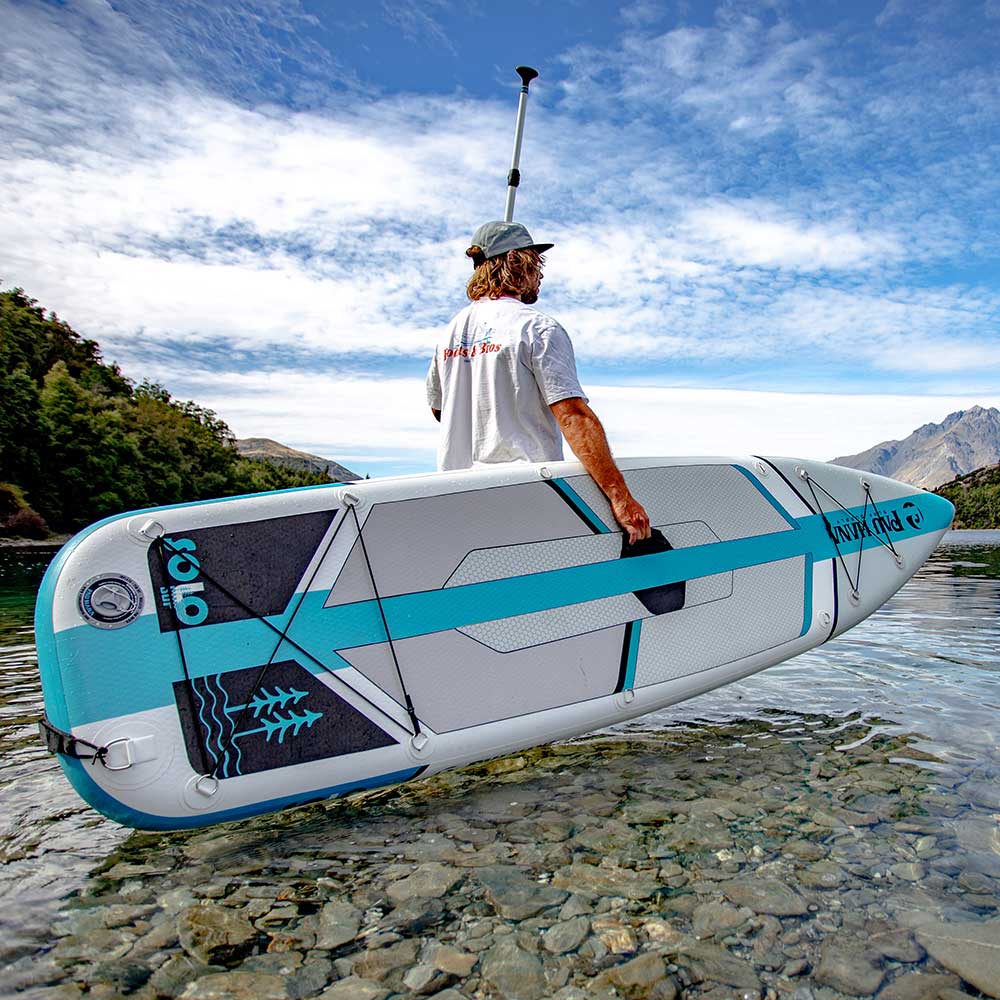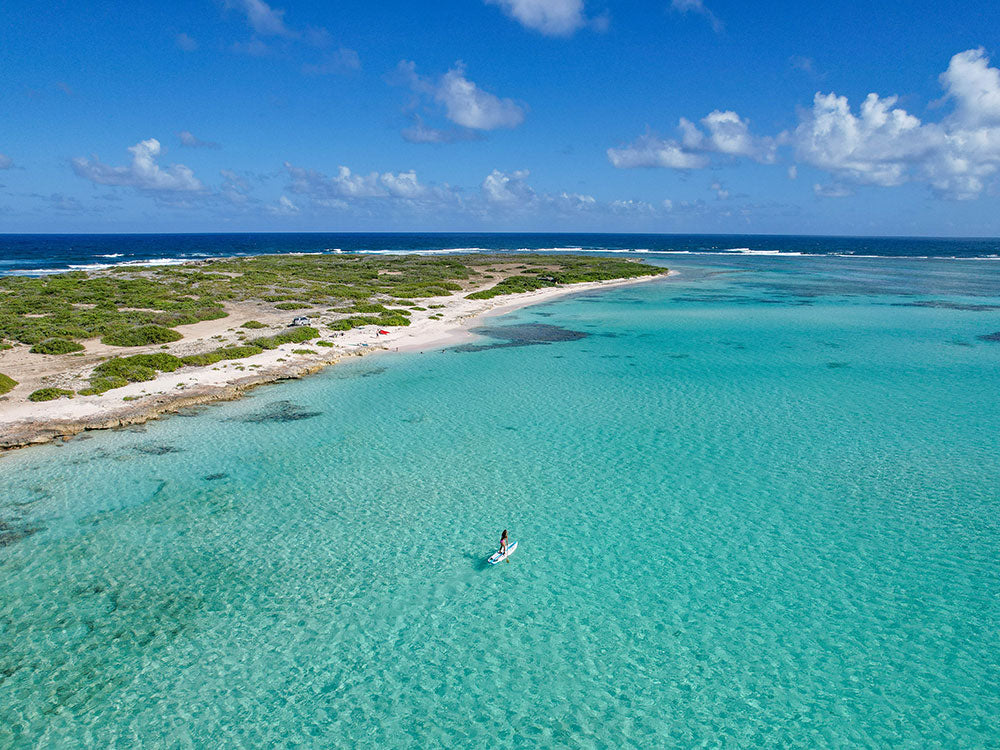Paddle Boarding Workouts for Weight Loss
A Comprehensive Guide
Article by Jen Chrimes

Paddle boarding, also known as stand-up paddleboarding (SUP), is not only a relaxing way to enjoy the water but, with some planning, it can also be an effective full-body workout that can contribute significantly to weight loss. This article explores the science behind paddleboarding's fitness benefits, how you can incorporate it into your weight loss routine, and how to plan a structured workout plan.
1. Why Paddle Boarding is Effective for Weight Loss
Paddle boarding engages multiple muscle groups, combining strength training, cardiovascular exercise, and core conditioning. Which means that paddleboarding as a full-body workout is effective for weight loss because:
- Core Strengthening: Balancing on a paddle board requires constant engagement of your core muscles. As you paddle, your abs, obliques, and lower back muscles work to stabilize your body, leading to stronger and more defined core muscles and an increase in balance over time.
- Cardiovascular Fitness: Cardiovascular exercise is the best form of exercise for burning calories and improving heart health. A moderate-intensity paddleboarding session can increase your heart rate and therefore elevate calorie expenditure. Studies indicate that engaging in regular cardiovascular exercise can significantly reduce body fat percentage, especially when combined with a macro balanced and calorie controlled diet.
- Full-Body Engagement: Paddle boarding involves almost every muscle in your body. Your legs provide stability, your arms and shoulders drive the paddle, and your back and core maintain balance. Full-body exercises are highly effective for weight loss because they burn more calories by working multiple muscle groups simultaneously.
2. Calories Burned While Paddle Boarding
The calories burned during paddleboarding depend on several factors, including your body weight, individual fitness, paddling intensity, and the water conditions. On average:
- Recreational Paddling: A leisurely paddle can burn about 300-450 calories per hour. According to the American Council on Exercise (ACE), activities that engage multiple large muscle groups, like paddleboarding, increase calorie burn due to the energy required to maintain balance and movement.
- Intense Paddling or Racing: Paddling vigorously can increase calorie expenditure to 600-750 calories per hour. High-intensity activities are known to boost metabolism, leading to greater post-exercise calorie burn through a process called excess post-exercise oxygen consumption (EPOC), where the body continues to burn calories after the activity has finished for a period of time.
- SUP Yoga: Practicing yoga on a paddleboard can burn around 200-500 calories per hour, depending on the difficulty of the poses and your balance efforts. The unstable surface of the paddleboard increases muscle activation compared to practicing on land, which can enhance calorie burn and muscle toning. Not to mention that paddle board yoga can increase your balancing which in turn can help improve your overall paddling ability.
3. Paddle Boarding Workout Routine for Weight Loss
To maximize weight loss and overall fitness, follow a structured paddleboarding workout plan that includes a mix of cardio, strength training, and core exercises.
Warm-Up (5-10 minutes): Start with gentle paddling to warm up your muscles, increase blood flow and elevate your heart rate.
Interval Training (20-30 minutes): Incorporate high-intensity intervals, such as paddling at maximum effort for 2 minutes, followed by 3 minutes of active recovery. Interval training is effective for burning fat and improving cardiovascular fitness due to its impact on EPOC (Excess post-exercise oxygen consumption).
Core-Focused Paddling (15-20 minutes): Core exercises are vital for weight loss as they help stabilize the spine and improve functional strength. Try paddling for 5 minuets while focusing on engaging the core through every paddle stroke. Transition to doing squats on your board with your paddle above your head in a stationary position, remember to focus on engaging the core through the movement, for 15 squats. Alternate from paddling to squats for the 15-20 mins.
Paddleboard Push-Ups (5-10 minutes): Perform push-ups on your board to tone your chest, shoulders, and triceps while challenging your balance. Strength training exercises like push-ups are essential for building lean muscle, which increases resting metabolic rate and aids in weight loss.
Cool Down (5-10 minutes): Finish your workout with slow paddling for 5-10 mins and stretching when you get back to shore to promote flexibility and reduce muscle soreness.

4. Incorporating SUP Yoga for Weight Loss
SUP yoga enhances the benefits of traditional yoga by incorporating balance and stability challenges on the water. This results in increased muscle activation and calorie burn. Practicing poses like Warrior Pose, Downward Dog, and Plank on a paddleboard can improve core strength, flexibility, and balance, all of which contribute to weight loss.
Science Behind SUP Yoga: Research indicates that performing exercises on unstable surfaces, such as a paddleboard, requires greater muscle activation compared to stable surfaces. This increased muscle engagement can lead to improved muscle strength, endurance, and calorie burn .
5. Tips for Success
To achieve your weight loss goals through paddleboarding, consider these tips:
- Consistency: Regular exercise is key to weight loss. Aim to paddle 3-4 times a week, gradually increasing the intensity of your workouts.
- Hydration: Staying hydrated is crucial during exercise, especially in hot weather. Bring water with you on your paddleboarding sessions.
- Proper Technique: Learning and maintaining proper paddling technique is essential for avoiding injury and maximizing the effectiveness of your workouts. If you're new to paddleboarding, consider taking a lesson from a certified instructor.
Conclusion
Paddle boarding is an effective and enjoyable way to lose weight and improve your overall fitness. By incorporating structured workouts, interval training, and SUP yoga into your routine, you can burn calories, build muscle, and enhance your cardiovascular health. With dedication and consistency, paddleboarding can help you achieve your weight loss goals while allowing you to enjoy the natural beauty of the water.
Start your paddleboarding fitness journey today, and experience the transformative benefits of this full-body workout.
References:
- ACE (American Council on Exercise). (n.d.). Calories burned during exercise. Retrieved from ACE website .
- LaForgia, J., Withers, R. T., & Gore, C. J. (2006). Effects of exercise intensity and duration on the excess post-exercise oxygen consumption. Journal of Sports Sciences, 24(12), 1247-1264.
- Behm, D. G., & Anderson, K. (2006). The role of unstable surfaces in resistance training. Strength & Conditioning Journal, 28(5), 64-72.
- Hibbs, A. E., Thompson, K. G., French, D., Wrigley, A., & Spears, I. (2008). Optimizing performance by improving core stability and core strength. Sports Medicine, 38(12), 995-1008.
How often should I paddleboard to see weight loss results?
Aim to paddleboard 3-4 times per week, incorporating a mix of steady paddling, interval training, and SUP yoga for the best results.
Can beginners use paddleboarding for weight loss?
Absolutely! Paddleboarding is suitable for all fitness levels, and beginners can start with short, easy sessions and gradually increase the intensity as they gain confidence.
What other benefits does paddleboarding offer besides weight loss?
In addition to weight loss, paddleboarding improves core strength, balance, coordination, and mental well-being. It’s also a low-impact exercise, making it gentle on the joints.
Can I do other exercises on a paddleboard?
Yes, you can incorporate exercises like push-ups, squats, and yoga poses to enhance your paddleboarding workout and target specific muscle groups.
How do I stay safe while paddleboarding for exercise?
Always wear a personal flotation device (PFD), stay hydrated, and be aware of weather conditions and water currents. If you're new, consider taking a lesson to learn proper technique.
What should I eat before and after a paddleboarding workout?
Before paddleboarding, eat a light meal or snack rich in carbohydrates and protein for energy. After your workout, focus on protein-rich foods to aid muscle recovery and replenish glycogen stores.









